Britain’s daily Covid cases have begun to flatten out amid an uptick in infections among older teenagers and adults in their early twenties, according to official figures.
Department of Health data showed another 30,215 positive tests were registered today, up just 3 per cent from 31,117 on last Thursday.
And the seven-day average for infections — which paints a clearer picture over the actual trend — plateaued for the fourth day in a row at around 26,000, after tumbling for almost a fortnight.
MailOnline analysis suggested the worrying trend may be down to cases rising among 15 to 24-year-olds for the first time in a month, which leading scientists claimed was likely sparked by ‘Freedom Day’ and the reopening of nightclubs.
But they did not rule out lower vaccination rates in the age groups and colder weather towards the end of the month also being behind the increase.
Daily Covid hospitalisations continued to fall today after dropping by a fifth in a week (down 20 per cent) to 727 admissions on the first day of August, the latest date available. Another 86 deaths were also recorded, similar to the 85 announced at the same time last week.
Dr Simon Clarke, a microbiologist at Reading University, warned today there was a risk infections in younger age groups could yet spill over into older age groups, with previous waves beginning in the young before rapidly picking up the pace among older, more vulnerable people.
He called on the over-50s to make sure they get their booster jabs when they are dished out, to ensure they have the best protection possible.
It comes as separate data today confirmed cases were genuinely declining last week — and that the blip was not down to a lack of testing. But the surveillance studies don’t reflect the current situation because they are lagging measures.
ZOE’s symptom-tracker branded its data — which showed a 22 per cent drop in people falling ill — as being the ‘good news the UK had been waiting for’.
Separate data from Public Health England’s showed rates fell in all but 12 of England’s 149 local authorities. And Test and Trace statistics revealed the shrinking outbreak helped to ease some of the ‘pingdemic’ chaos that has disrupted the nation over the past month.
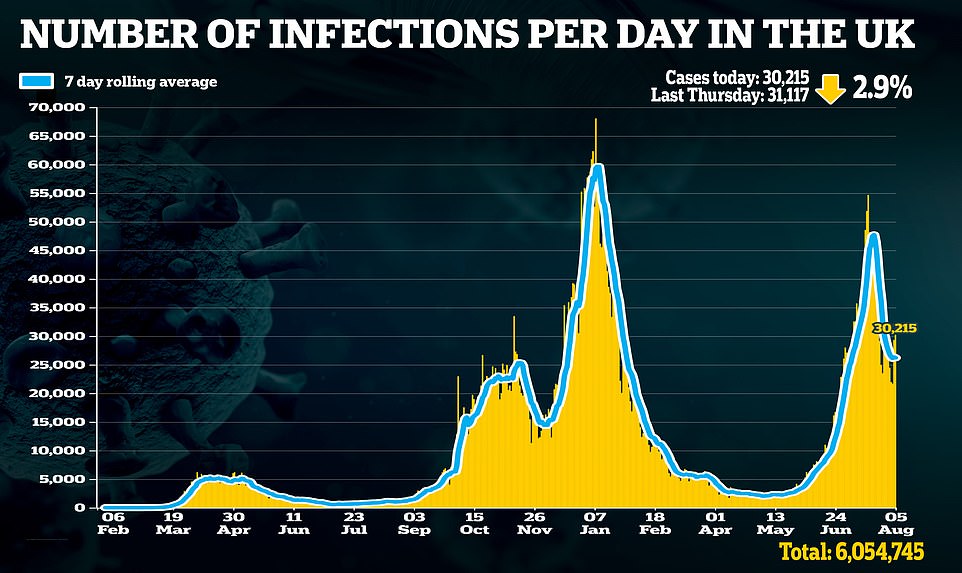

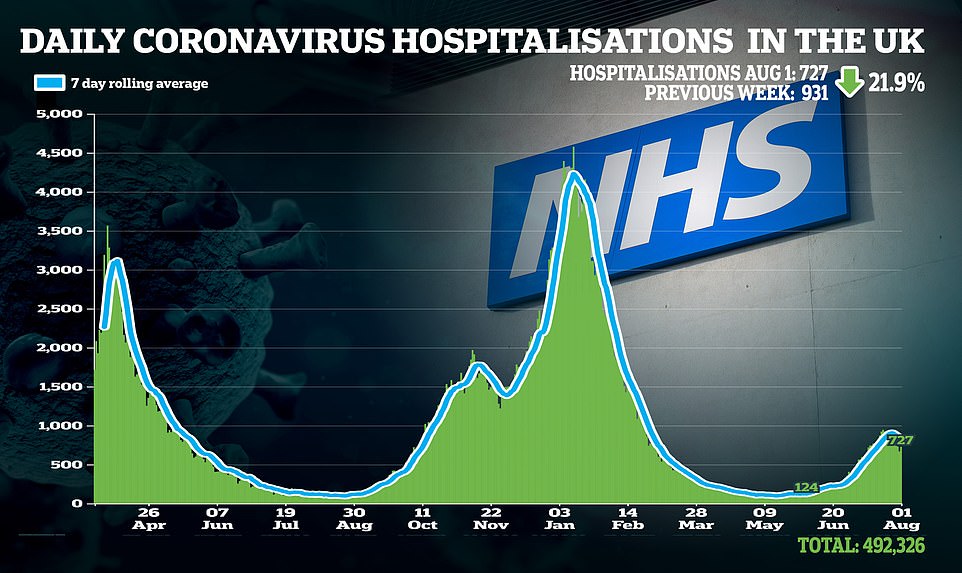
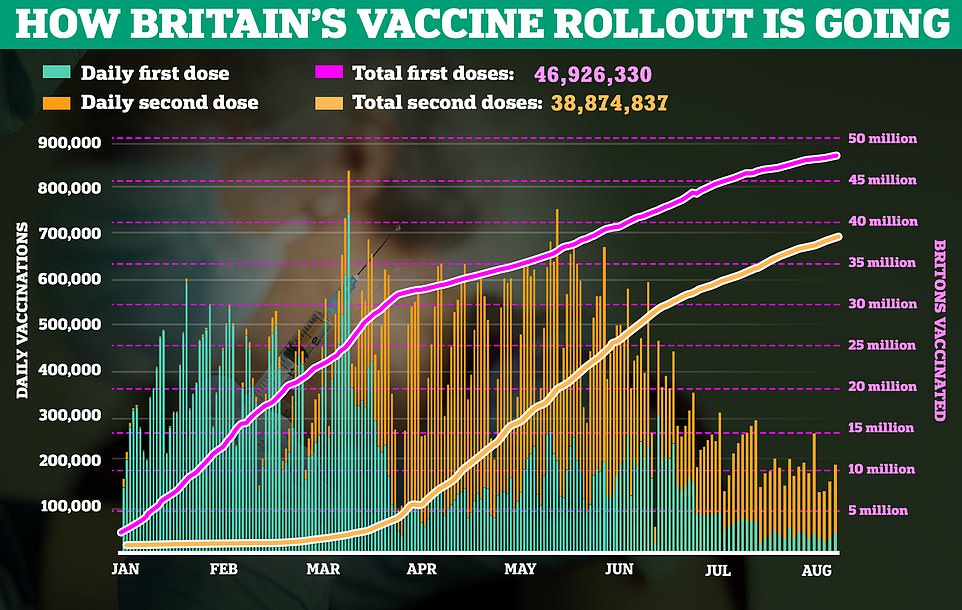

Covid cases are rising among adults in their early twenties and the oldest teenagers in England, and are static among adults in their late twenties. Experts said this could be due to Freedom Day easings and the long daylight hours encouraging more socialising. Younger age groups tend to do more socialising than older age groups
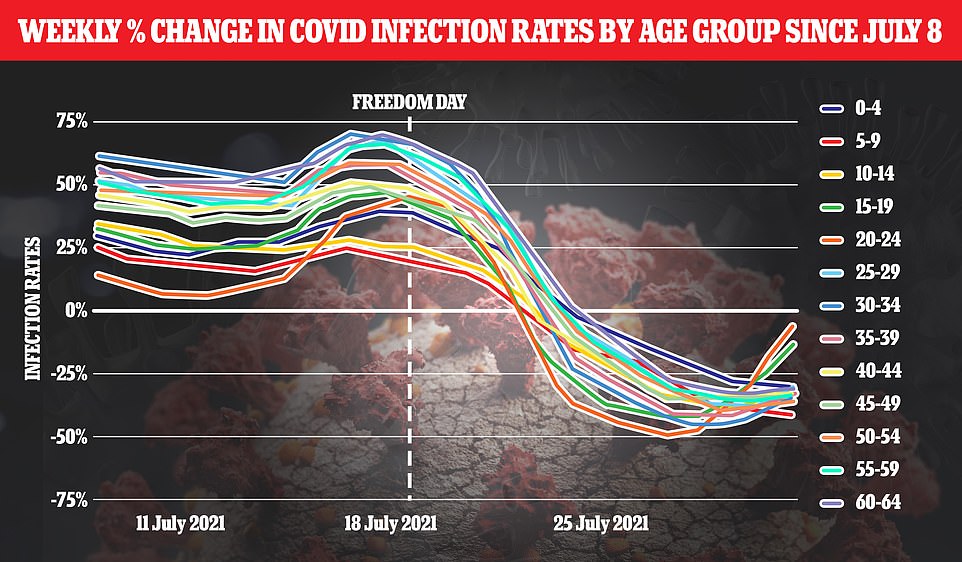
Covid cases are still dropping week-on-week in all age groups, but the rate of decrease has slowed considerably among adults in their early twenties. It could switch to a rise in cases in the coming days
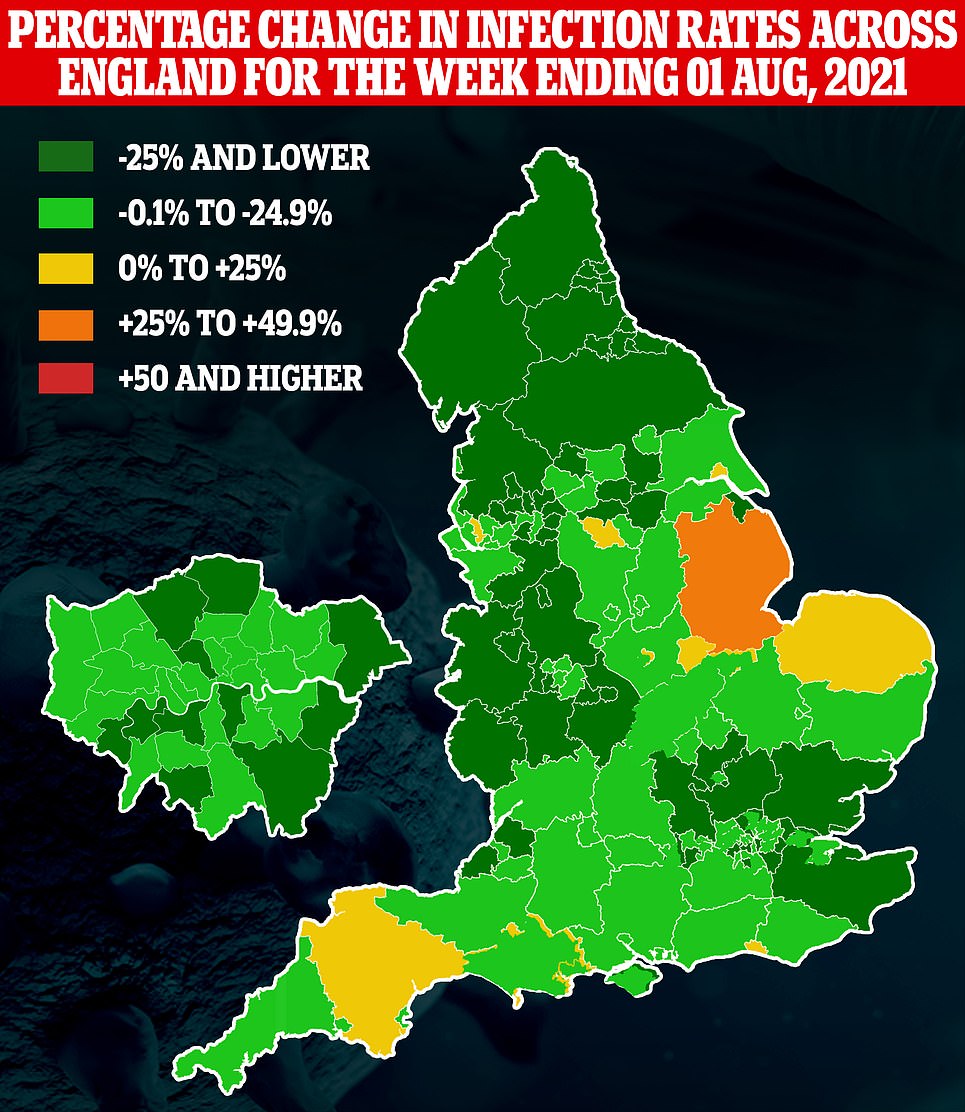
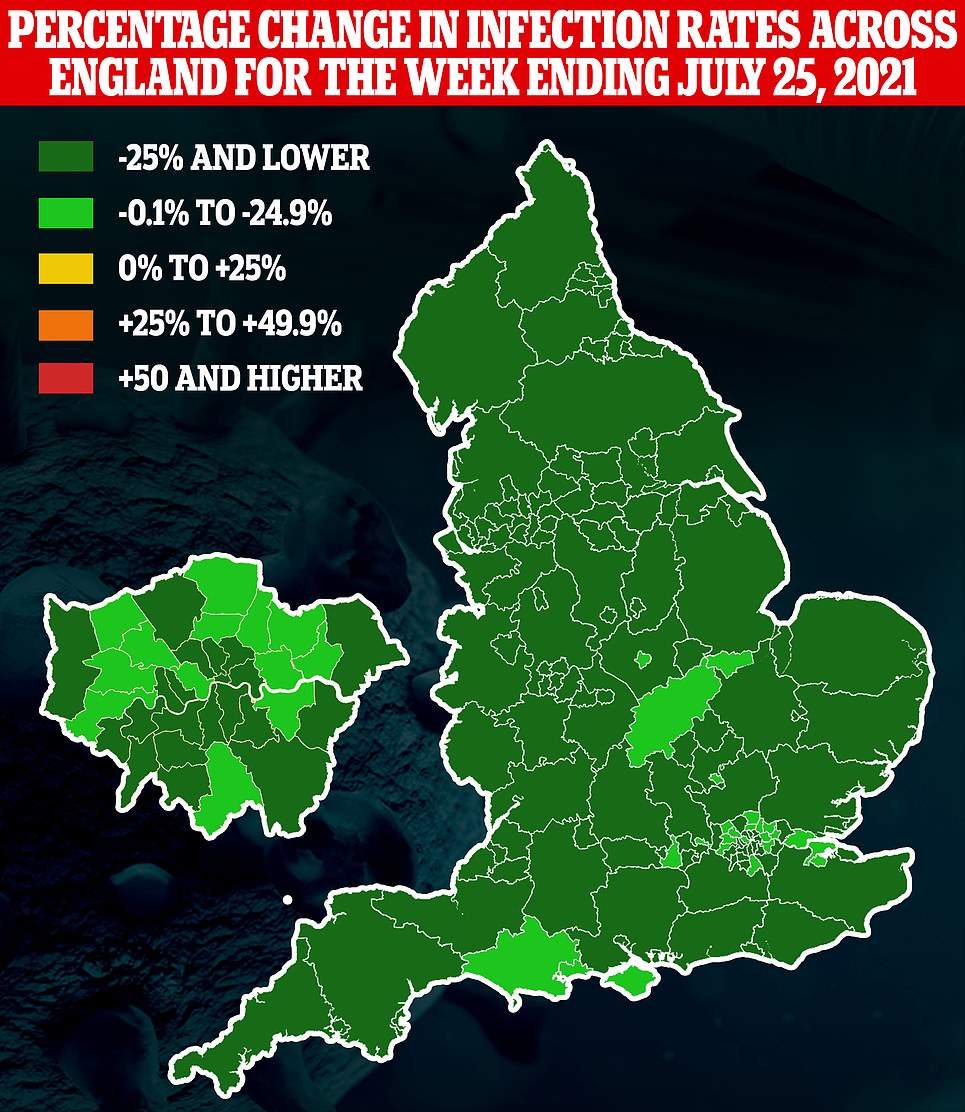 ‹ Slide me ›
‹ Slide me ›
Covid cases in England fell in all but 12 of the country’s 149 local authorities last week, Public Health England data showed. The slowdown comes as experts say the data will begin to reveal the impact of July 19 lockdown easings

Experts said Freedom Day easings including the reopening of nightclubs could be behind the rise. But they also said the longer daylight hours leading to more mixing were likely playing a part . Pictured are revellers on the dancefloor at Powerhouse nightclub in Newcastle on Freedom Day

The Covid Symptom Study estimated cases fell by almost a quarter last week, after saying they had plateaued. It estimated 46,905 people are now catching Covid every day, down from almost 60,000 previously
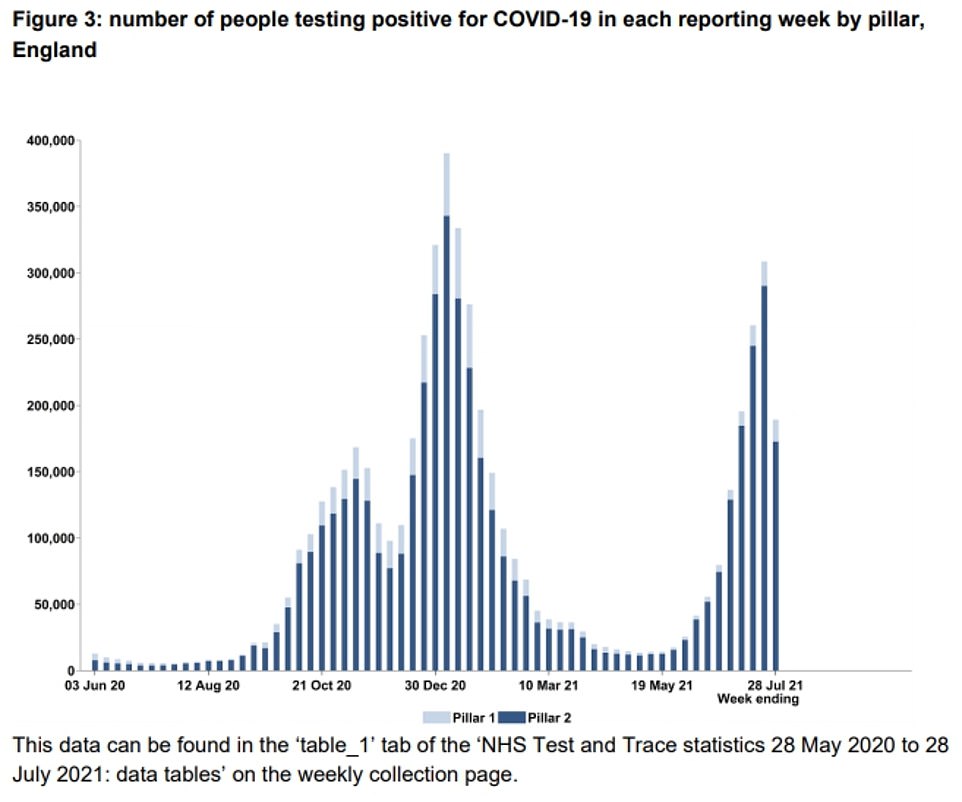
Test and Trace data showed Covid cases dropped by almost 40 per cent a week ago, in yet another sign the third wave has peaked. They said 189,232 Britons tested positive for the virus over the seven days to July 28
In other Covid developments today:
Teenagers rebelled against anti-vaccination parents and hijacked debate over the safety of the Covid jab saying they wanted to be inoculated;One in five Covid patients currently in hospital are aged between 18 and 34-years-old, new NHS boss Amanda Pritchard revealed;Number of alerts sent by NHS contact-tracing app plunged by 43 per cent last week before the software was tweaked in a sign ‘pingdemic’ chaos may finally be over;Latest vaccination figures showed nearly 38.8million Britons — or 73.5% of adults — have got two doses of the vaccine and 46.9million — or 88.7% had two doses. There were 165,669 second doses dished out yesterday, and 33,334 first doses;Almost 400,000 Britons have struggled with ‘long Covid’ for a year, a study claimed.
MailOnline’s analysis of the Government data was based on the date tests were carried out, meaning they also lag behind slightly.
But specimen date figures — as opposed to reported date — offer one of the most accurate ways of tracking the state of the outbreak.
It can take a week between someone getting infected with coronavirus and testing positive because of the time taken for symptoms to develop and swabs to be analysed.
The statistics showed the weekly infection rate — the number of positive tests per 100,000 people — among 20-24 year olds stood at 734 on July 30. This equated to around one in 136 adults in the age group having Covid.
The rate is still lower than it was the week before (783.2), but it has been up on every day since July 26 (633.9).
Among 15 to 19-year-olds, the Covid infection rate has also been trending upwards since July 26 (from 694.2 to 724.6).
One-in-five Covid patients currently in hospital are aged between 18-34, new NHS boss reveals 
New NHS boss Amanda Pritchard (pictured)
A fifth of Covid patients currently in hospital are aged between 18 and 34, the head of the NHS revealed today.
Amanda Pritchard, who took over as chief executive of the health service last week, urged young people to get a vaccine.
In her first major interview since taking the role, she said there is ‘no doubt’ the roll-out is keeping people out of hospital and saving lives.
Some 20 per cent of the 5,000 patients currently in hospital with the virus are young people, according to NHS data. This is up from 5.4 per cent — around one in 20 — at the peak of the second wave in January.
It does not mean the virus now poses a bigger threat to youngsters. Instead, it shows how the current crop of vaccines have prevented tens of thousands of older adults from being hospitalised.
Just 64.1 per cent of 30 to 34-year-olds have had a jab so far, and uptake falls to just 60.8 per cent for people in their mid to late 20s. For comparison, more than 90 per cent of over-60s have been jabbed.
Ministers have already roped in Uber and Deliveroo to offer deals for young people in a bid to encourage them to come forward.
It comes as Government data shows the number of patients being hospitalised with Covid is continuing to fall, in a sign that the worst part of the summer wave may be over.
However, experts are concerned cases may creep up again this week, which could see the NHS come under more pressure towards the end of the month. It can take several weeks for infected patients to become severely ill.
Advertisement
Dr Raghib Ali, an epidemiologist at Cambridge University, told MailOnline it would ‘make sense’ for nightclubs to be behind the rise in younger age groups.
He said: ‘We don’t have direct data, but given that was the only change really after Freedom Day it seems likely.
‘We don’t know the proportion of younger adults that go to nightclubs, but it will be a higher proportion than those in older age groups.’
He also said lower vaccine uptake could be a factor.
Official figures show almost three million people in their twenties are still to get a first dose of the Covid vaccine, despite the drive being open to them since mid-June.
Dr Clarke pointed to a spike in cases after the Government launched its Eat-Out-To-Help-Out scheme last summer to explain the rise in younger age groups, saying: ‘If you wind the clock back 12 months this is what happened then.
‘[The rise] is because they mix more, that they are more likely to be social in the summer months, there are more social opportunities and these are being taken up by young people.’
He added that the weather could be a factor, after colder temperatures at the end of July may have led to more people socialising indoors where the virus finds it easier to spread.
Met Office data shows temperatures dipped after the last weekend in July from highs of 29C (84F) seen earlier in the month when cases were falling to around 20C (68F).
Asked whether the rise in cases was behind the U-turn on vaccinating children yesterday, he said: ‘I suspect they will have looked at the data and it would be one of the factors that they may consider.
‘But it is difficult to know how much weight they would put on that.’
Health chiefs had access to a plethora of data — most notably evidence on how safe the jabs are — to make the decision.
Dr Clarke added infections could spill over to older age groups in the coming weeks.
He said: ‘We should be concerned about that if people don’t get their boosters because with dealing in the realms of the unknown there is the possibility that immunity would start to wane.’
More than 30million over-50s are set to be offered a third dose of the Covid vaccine from next month amid fears in scientists that protection from jabs could wane over time.
Dr Jonathan Stoye, a virologist at the Francis Crick Institute, said the rise in infections in younger people was likely down to them mixing more and being less likely to still follow face mask and social distancing guidance.
‘It is either because they have more social contact individually than older people or because they have given up some of the restrictions more easily,’ he told MailOnline. ‘They feel less inhibited about wearing face masks and things like that.’
Professor Karl Friston, an Independent SAGE member modelling the spread of Covid in the country, said the ‘selective’ rise in cases in young people was ‘certainly consistent with clubs reopening’.
The neurologist added: ‘This speaks to a key determinant of viral spread; namely, contact rates and personal mitigating behaviours.
‘These factors have a greater effect on transmission the closer we get to a population immunity threshold. This probably explains why the summer wave peaked when it did — because we are still, as a population, behaving in a careful and considerate way, even though many restrictions have been lifted.’
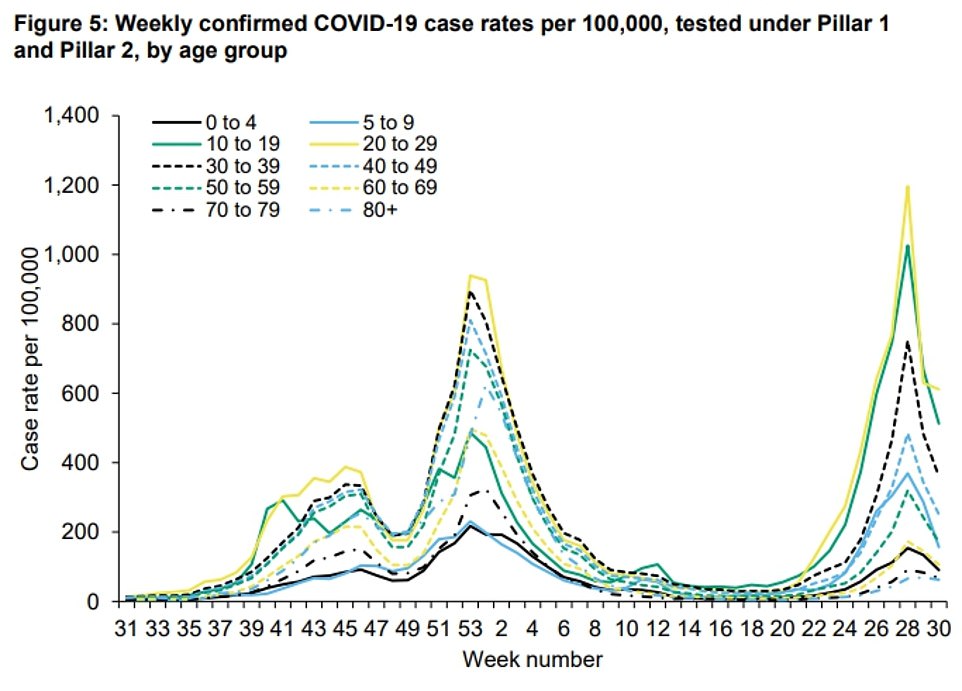
PHE data showed Covid cases fell in every age group in England in the week to August 1. But this data does not cover the latest period where separate Department of Health figures showed cases began to rise again

Covid cases were also still falling across every region of England in the week to August 1, PHE said
Just 3.3% of Brits returning from Mexico last month had Covid compared to 2.9% from Spain
Infection rates are only marginally higher among travellers returning to Britain from Mexico compared to Spain, raising questions about why it was moved to the red list.
Official Government figures also show Spain — which escaped any further sanctions — is 35 times more popular for tourists, meaning hundreds of Covid cases are actually being imported from the holiday hotspot. Only dozens of infected people are flying back from Mexico.
British holidaymakers are now scrambling to get back from Mexico before strict hotel quarantine rules come into place on Sunday.
The decision gave people just three days’ notice, with some only discovering the news while mid-air. Plane tickets allowing Britons to make it back in time are on sale for up to £7,000.
But Spain — which scientists say has a similar-shaped outbreak — stayed in the amber category, despite rumours that the holiday plans of tens of thousands of Brits were on the brink of ruin.
Experts have now called on ministers to publish the full set of data to justify last night’s decision to place Mexico onto the red list, with the rules set to kick in at 4am on August 8.
The Department for Transport released a spreadsheet of ‘key’ statistics used by ministers to inform their policies.
Advertisement
It came as the symptom-study said cases had fallen last week, although infections were still highest among people who had not received the vaccine.
Statistics from health data company ZOE and King’s College London suggested there were 29,620 Covid cases a day among the un-vaccinated.
For those that had a first dose there were predicted to be 6,534 cases a day, and for people that had both doses there were 10,751 cases a day.
This does not mean vaccines do not work. Scientists say the shift was obviously going to happen because so many more people are now double-jabbed.
Lead scientist on the ZOE Covid app and reader at King’s College London Dr Claire Steves said: ‘According to the latest incidence figures, the number of new daily cases in the UK has finally begun to fall.
‘This is the good news the UK has been waiting for but, we mustn’t get ahead of ourselves, this pandemic definitely isn’t over yet as cases remain very high.’
The app relies on daily reports from more than a million Brits on whether they are feeling unwell, what symptoms they are suffering and if they have tested positive for Covid to estimate the spread of the virus.
Professor Paul Hunter, an infectious diseases expert at the University of East Anglia, warned last week data from the app was becoming less reliable because vaccines had turned Covid into a ‘bad cold’, making it harder to pick out from other infections.
PHE’s weekly report showed Covid cases were falling in every age group and every region in the week to August 1, but this did not cover the latest couple of days when official figures suggest Covid cases had stopped falling.
A more granular look at the data revealed cases fell in all but 12 of England’s 149 local areas.
Lincolnshire was the only area to see a more than 25 per cent uptick in infections, while Peterborough, Brighton and Hove, Sheffield, Rutland, Norfolk, Bournemouth and Dorset saw cases rise by more than 10 per cent. Hull, Leicester, Devon and Knowsley saw a slight rise in cases.
The test positivity rate — the proportion of swabs that detect the virus — also continued to decline, suggesting that the fall in cases was genuine and not because fewer swabs were carried out.
Separate data from Test and Trace suggested Britons are still turning away from the service in droves after the proportion of Covid-infected Britons handing over details of their close contacts fell to its lowest level since May.
Official figures showed out of 158,000 people who tested positive for Covid in the week to July 28, almost 40,000 (23.9 per cent) were listed as unable to hand over details of their close contacts after testing positive.
For comparison, in the previous seven-day spell 23.1 per cent of Covid-infected people did not hand over details of their close contacts, and at the start of May only 16 per cent did not do this.
The proportion of close contacts reached by Test and Trace also fell in the same period — despite the number of close contacts dropping by 200,000.
Figures showed out of more than 400,000 close contacts, almost 45,000 were not reached (10.7 per cent). In the previous week out of 600,000 close contacts 60,000 were not reached (10.2 per cent).
Test and Trace lists someone as not able to give details of close contacts if ‘they were successfully reached by NHS Test and Trace, but either had no recent close contacts or could not provide details of close recent contacts to pass on for further contact tracing’.
Britons who are contacted by Test and Trace are required to self-isolate for ten days. But those who are ‘pinged’ by the NHS app can choose whether to follow the guidance.
Source link : https://www.dailymail.co.uk/news/article-9865475/Britains-daily-Covid-cases-fall-just-3-week-curve-begins-flatten-out.html











